Every day, a novice aquarium enthusiast must add water to replace that lost to evaporation.
ATK devices are frequently the first automation equipment acquired for this reason alone.
But sometimes, it comes to catastrophic aquarium failures or, even worse, flooded homes and businesses. An ATK malfunction is one of the most common culprits.
If you’re like most others, you’re wondering why something isn’t functioning.
Is Neptune ATK not working?
When your Neptune ATK is not working, first check the PMUP output. Make sure that PMUP is powered on. Alter the minimum time to conduct a trial run.
Secure the optical sensor plugs. Test the sensor as it is submerged or not. Defer statement and log PMUP output.
Check out the whole article for briefings!
Why Is Neptune ATK not Working?
Evaporation losses can be replaced with the ATK (Automatic Top Off Kit). It is a simple, freestanding, and full solution.
ATO devices aren’t all the same. Because they are built with low-quality parts and offer minimal protection against these disasters, many ATO on the market is difficult to assemble and install.
You don’t have to feel like an ATO is both good and bad if you have one!
These Neptune ATK standalone Problems Most Frequently Occur and stop working; check these out:
For a variety of reasons, this can happen. The reasons for this are included below-
Problem 1: ATK Is Not Filling Even Though the Water Level Is Below the Bottom Optical Sensor.
Your FMM module is unable to function because it lacks electricity. Another cause is your FMM has been set to alarm. The FMM module can be used to verify this information.
Your ATK won’t be able to function again for another hour, especially when it has been full in the last hour.
Another reason is your FMM module and PMUP is not linked. This causes a lack of nitrogen in the aquarium, and chaeto turns white.
Solution
Make sure your FMM’s status light is a solid blue color. Otherwise, ensure the power supply is hooked to an outlet with electricity.
The ATK can only be refilled once every hour. Your FMM’s PMUP starts working immediately after you turn it off and back on again.
The PMUP should be running if the FMM’s light is green. Consult experts if the indicator is green and the PMUP is connected.
Problem 2: FMM Has Been Replaced With an Alarm System
There are several reasons why this might be the case, but the most prevalent include:
A warning has been sent by the IQ-Fill alert. If this is the case, the FMM module will sound an audible beep.
Another reason is a beep from the FMM, and the reservoir’s optional optical sensor is not covered. Optical sensor 1 isn’t linked to the FMM module.
Solution
For each fill, IQ-Fill determines the amount of water required and the maximum run duration. The maximum run time for your PMUP is three times what it normally operates at.
IQ-Fill may activate if the ATO reservoir is empty. Power cycling the FMM module is all that is required to reset IQ-Fill. You can use Rowaphos or GFO as you prefer.
After a power cycle, the aquarium’s maximum run time is 5 minutes until enough refills. Make sure the ATK reservoir is topped off.
Problem 3: Still Fresh Water Drains Into Sump Once PMUP Is Shut Off.
This happens because the water level in the ATK reservoir is higher than the sump level.
Solution
The ATK comes with a siphon break that can be turned on or off. Change the ATK reservoir’s position so that its water level doesn’t exceed the sump’s water level.
You can check these suggested tools for changing the ATK reservoir’s position.
While the pump is running, the siphon break fitting is expected to leak water back into the reservoir.
What You Should Do If Your ATK Doesn’t Work As It Should
Here are some basic steps to do for your ATK better perform as expected:
Step 1: Check the PMUP Output
Verify that the PMUP output tile on your dashboard is set to AUTO.
Step 2: Make Sure the Power Is On
Confirm that the PMUP is powered on. Pump water by manually moving the PMUP slider to the ON position.
Verify that the FMM’s 24v power adapter is firmly inserted into the FMM. It receives power before trying to use it.
Also, check that the PMUP is submerged in the ATO reservoir. The tubing should not be kinked or obstructed.
Remember that you must return the slider to its default settings before proceeding.
Step 3: Alter the Minimum Time
Remove the Minimum Time to 060:00, Then OFF to 000:01 to conduct a trial run. The benefit of this is that you won’t have to wait an hour.
Remember to add that line back into the programming after testing. It serves as a safety net. For better
Step 4: Secure the Optical Sensor Plugs
Check to ensure that the optical sensor plugs are securely fastened into their FMM sockets. Push them as hard as you can until they “click” together.
Step 5: Check the Detection
Ensure that your FMM module is accurately detecting the optical sensors. Click Configure in the FMM module parameters. Then verify outputs 1 and 2 are both identified as optical sensors.
Step 6: Clean Your Sensor
If your optical sensors are dirty, clean them with a microfiber cloth.
Step 7: Test the Sensor
It would be best if you submerged the lower end of the sensor in water to check the sensor.
A sensor that doesn’t function as an optical sensor is faulty.
Or it’s not properly plugged in or in the wrong port. The higher sensor should be tested in the same way. A faulty sensor can cause elegant coral to die.
Step 8: Defer Statements
Defer statements cause a ten-second delay before turning the pump on or off (off for 4 seconds). The Defer timings can be slowed down or even removed during testing.
Always return them to their usual values after the tests are through.
Step 9: Log PMAP Output
The PMUP output should be logged. To keep tabs on its activities, you can do so from a distance and go back and review how it worked.
There is also built-in logic in the FMM module that “learns” your aquarium’s usual fill time. It restricts how much water it can pump out.
This system provides an extra layer of safety against floods and overfilling.
FAQs
How to Reset Apex ATK?
The reset button is located behind a small hole in the FMM faceplate. It is just to the right of the AquaBus jacks.
Using a bent-open paperclip or another thin device, hold the reset button until the indicator light turns orange. For a few seconds, unplug the FMM’s 24V power cord.
Using ATK, how do I link apex?
There is no learning curve if you already own an Apex of some sort. Connect the AquaBus connection to your Apex. Start the setup process in Apex Fusion after plugging in all the components.
To access Apex local, how do I establish a connection?
Your Apex must be connected to your router. Your Apex base unit has an ethernet connector on the rear.
So plug your ethernet cable there. After that, plug the Ethernet wire into one of the router’s auxiliary ports.
Final Words
Problems with Neptune atk not working and possible solutions have been covered extensively in this article.
We’re hoping that this information will assist you in better understanding what’s going on. Also, how to fix it.
In addition to saving you time, the ATK shields your tank and home from harm. Consult with specialists if you can’t fix the problem on your own.

